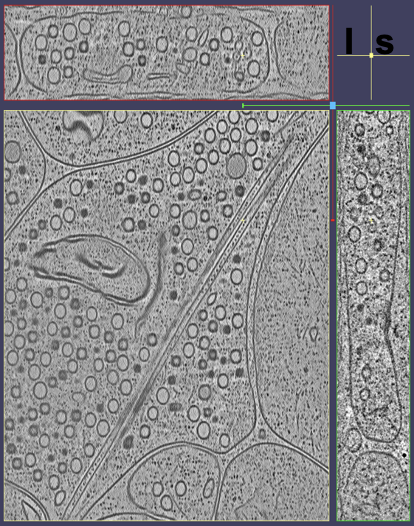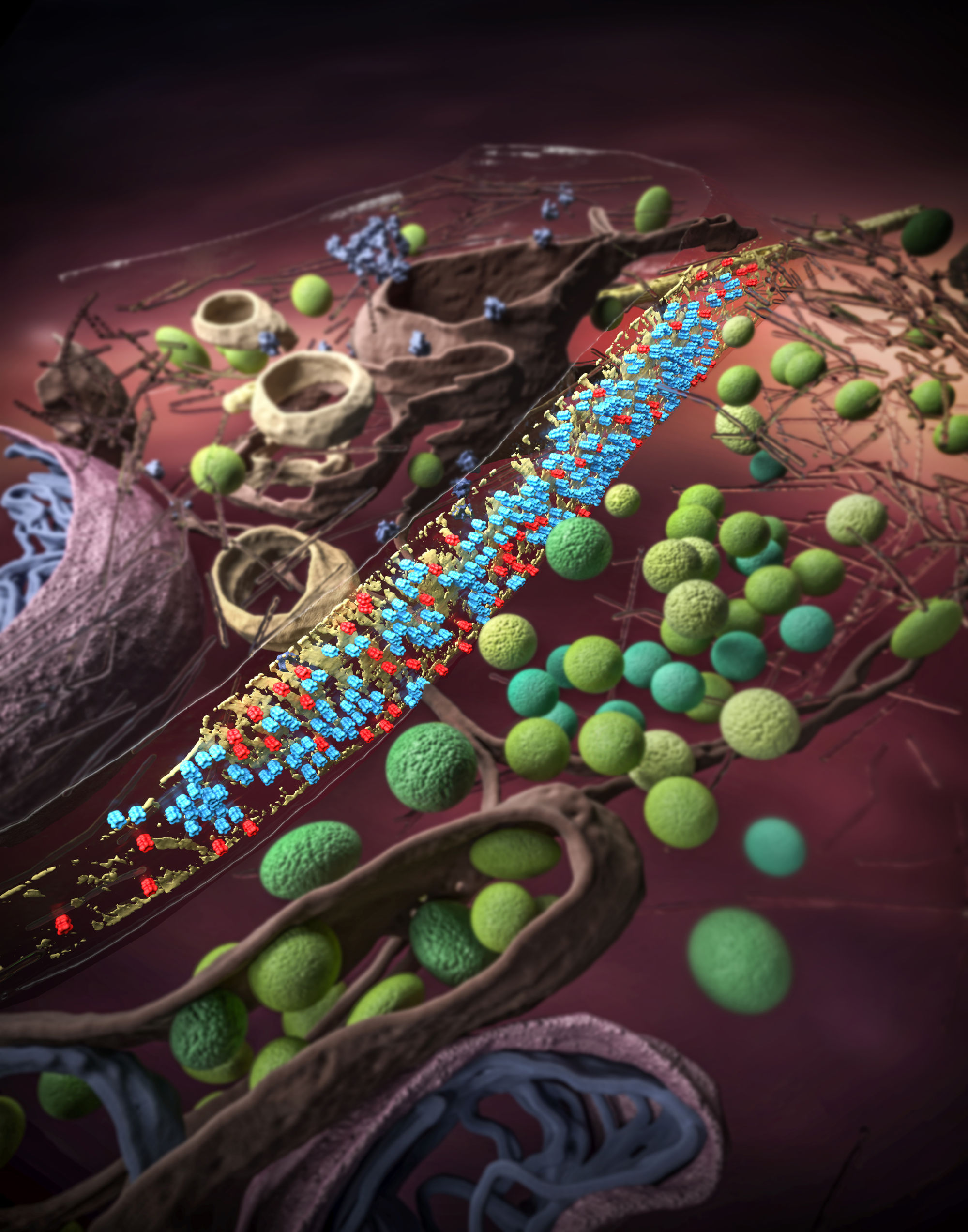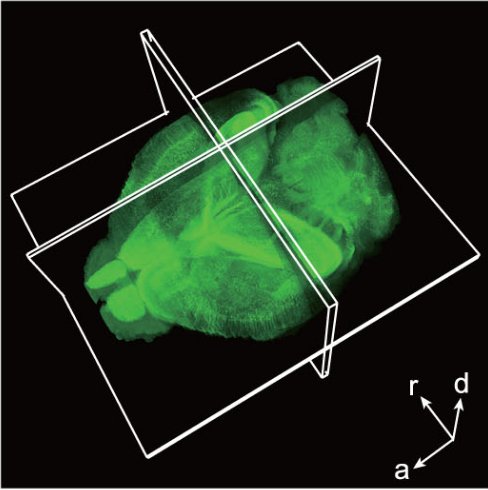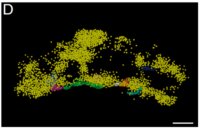Publications
Group highlights
(For a full list see below)

Cryogenic electron tomography (cryoET) allows visualization of cellular structures in situ. However, anisotropic resolution arising from the intrinsic “missing-wedge” problem has presented major challenges in visualization and interpretation of tomograms. Here, we have developed IsoNet, a deep learning-based software package that iteratively reconstructs the missing-wedge information and increases signal-to-noise ratio, using the knowledge learned from raw tomograms. Without the need for sub-tomogram averaging, IsoNet generates tomograms with significantly reduced resolution anisotropy. Applications of IsoNet to three representative types of cryoET data demonstrate greatly improved structural interpretability: resolving lattice defects in immature HIV particles, establishing architecture of the paraflagellar rod in Eukaryotic flagella, and identifying heptagon-containing clathrin cages inside a neuronal synapse of cultured cells. Therefore, by overcoming two fundamental limitations of cryoET, IsoNet enables functional interpretation of cellular tomograms without sub-tomogram averaging. Its application to high-resolution cellular tomograms should also help identify differently oriented complexes of the same kind for sub-tomogram averaging.
Liu YT, Zhang H, Wang H, Tao CL, Bi GQ* & Zhou ZH*.
Nature Communications 13, Article number: 6482 (2022)

The human monoclonal antibody C10 exhibits extraordinary cross-reactivity, potently neutralizing Zika virus (ZIKV) and the four serotypes of dengue virus (DENV1-DENV4). Here we describe a comparative structure-function analysis of C10 bound to the envelope (E) protein dimers of the five viruses it neutralizes. We demonstrate that the C10 Fab has high affinity for ZIKV and DENV1 but not for DENV2, DENV3, and DENV4. We further show that the C10 interaction with the latter viruses requires an E protein conformational landscape that limits binding to only one of the three independent epitopes per virion. This limited affinity is nevertheless counterbalanced by the particle’s icosahedral organization, which allows two different dimers to be reached by both Fab arms of a C10 immunoglobulin. The epitopes’ geometric distribution thus confers C10 its exceptional neutralization breadth. Our results highlight the importance not only of paratope/epitope complementarity but also the topological distribution for epitope-focused vaccine design. .
Sharma A, Zhang X, Dejnirattisai W, Dai X, Gong D, Wongwiwat W, Duquerroy S, Rouvinski A, Vaney MC, Guardado-Calvo P, Haouz A, England P, Sun R, Zhou ZH, Mongkolsapaya J, Screaton GR, Rey FA.
Cell 184(25), 6052-6066 e18 (2021).

Whole-brain mesoscale mapping in primates has been hindered by large brain sizes and the relatively low throughput of available microscopy methods. Here, we present an approach that combines primate-optimized tissue sectioning and clearing with ultrahigh-speed fluorescence microscopy implementing improved volumetric imaging with synchronized on-the-fly-scan and readout technique, and is capable of completing whole-brain imaging of a rhesus monkey at 1 × 1 × 2.5 µm3 voxel resolution within 100 h. We also developed a highly efficient method for long-range tracing of sparse axonal fibers in datasets numbering hundreds of terabytes. This pipeline, which we call serial sectioning and clearing, three-dimensional microscopy with semiautomated reconstruction and tracing (SMART), enables effective connectome-scale mapping of large primate brains. With SMART, we were able to construct a cortical projection map of the mediodorsal nucleus of the thalamus and identify distinct turning and routing patterns of individual axons in the cortical folds while approaching their arborization destinations.
Xu F#, Shen Y#, Ding LF#, Yang CY#, Tan H, Wang H, Zhu QY, Xu R, Wu FY, Xu C, Li QW, Su P, Zhang LI, Dong HW, Desimone R, Xu FQ, Hu XT, Lau PM* & Bi GQ*.
Nature Biotechnology 39, Pages: 1521–1528 (2021)

Information processing in the brain depends on specialized organization of neurotransmitter receptors and scaffolding proteins within the postsynaptic density. However, how these molecules are organized in situ remains largely unknown. In this study, template-free classification of oversampled sub-tomograms was used to analyze cryo-electron tomograms of hippocampal synapses. We identified type-A GABA receptors (GABAARs) in inhibitory synapses and determined their in situ structure at 19-Å resolution. These receptors are organized hierarchically: from GABAAR super-complexes with a preferred inter-receptor distance of 11nm but variable relative angles, through semi-ordered, two-dimensional receptor networks with reduced Voronoi entropy, to mesophasic assembly with a sharp phase boundary. These assemblies likely form via interactions among postsynaptic scaffolding proteins and receptors and align with putative presynaptic vesicle release sites. Such mesophasic self-organization might allow synapses to achieve a Goldilocks state, striking a balance between stability and flexibility and enabling plasticity in information processing.
Liu YT, Tao CL, Zhang XK, Xia WJ, Shi DQ, Qi L, Xu C, Rong S, Li XW, Lau PM, Zhou ZH, Bi GQ.
Nature Neuroscience 23, Pages: 1589–1596 (2020)

Here, we describe a new microscopy method of Volumetric Imaging with Synchronized on-the-fly-scan and Readout (VISoR) for high-throughput, high-quality brain mapping.
Wang H, Zhu Q, Ding L, Shen Y, Yang CY, Xu F, Shu C, Guo Y, Xiong Z, Shan Q, Jia F. et.al.
National Science Review, 6(5), pp.982-992.

We find that induction of late-phase sLTP at synaptic spines is associated with a preceding increase in mitoflash frequency occurring in nearby dendritic shafts, whereas mitoflash activity remains unaltered during induction of only short-term spine enlargement.
Fu ZX, Tan X, Fang H, Lau PM, Wang X, Cheng H, Bi GQ.
Nature communications. 2017 Jun 26;8(1):1-2.

our study quantified the kinetics of vesicle recycling and kinetically dissected the whole vesicle pool in the calyceal terminal into the readily releasable pool (∼0.6%), the readily priming pool (∼46%), the premature pool (∼33%), and the resting pool (∼20%).
Qiu, X., Zhu, Q. and Sun, J.
Proceedings of the National Academy of Sciences, 112(15), pp.4779-4784.
Full List
Isotropic reconstruction for electron tomography with deep learning
Liu YT, Zhang H, Wang H, Tao CL, Bi GQ* & Zhou ZH*.
Nature Communications 13, Article number: 6482 (2022)
The epitope arrangement on flavivirus particles contributes to Mab C10’s extraordinary neutralization breadth across Zika and dengue viruses
Sharma A, Zhang X, Dejnirattisai W, Dai X, Gong D, Wongwiwat W, Duquerroy S, Rouvinski A, Vaney MC, Guardado-Calvo P, Haouz A, England P, Sun R, Zhou ZH, Mongkolsapaya J, Screaton GR, Rey FA.
Cell 184(25), 6052-6066 e18 (2021).
High-throughput whole-brain mapping of rhesus monkey at micron resolution
Xu F#, Shen Y#, Ding LF#, Yang CY#, Tan H, Wang H, Zhu QY, Xu R, Wu FY, Xu C, Li QW, Su P, Zhang LI, Dong HW, Desimone R, Xu FQ, Hu XT, Lau PM* & Bi GQ*.
Nature Biotechnology 39, Pages: 1521–1528 (2021)
Mesophasic organization of GABA A receptors in hippocampal inhibitory synapses
Liu YT, Tao CL, Zhang XK, Xia WJ, Shi DQ, Qi L, Xu C, Rong S, Li XW, Lau PM, Zhou ZH, Bi GQ.
Nature Neuroscience 23, Pages: 1589–1596 (2020)
Structure and plasticity of silent synapses in developing hippocampal neurons visualized by super-resolution imaging.
Xu C#, Liu HJ#, Qi L , Tao CL, Wang YJ, Shen ZY, Tian CL, Lau PM* & Bi GQ*.
Cell Discovery 6:8 (2020).
Biphasic exocytosis of herpesvirus from hippocampal neurons and mechanistic implication to membrane fusion.
Liu YT#, Shivakoti S#, Jia F, Tao CL, Zhang B, Xu FQ, Lau PM, Bi GQ* & Zhou ZH*.
Cell Discovery6:2 (2020).
High frequency optogenetic activation of inputs to the lateral amygdala forms distant association with foot-shock.
Li F, Jia CH, Huang J, Bi GQ* & Lau PM*.
Molecular Brain 13:44 44 (2020).
An Ultra-Sensitive Step-Function Opsin for Minimally Invasive Optogenetic Stimulation in Mice and Macaques.
Gong X#, Mendoza-Halliday D#, Ting JT#, Kaiser T, Sun XY, Bastos AM, Wimmer RD, Guo BL, Chen Q, Zhou Y, Pruner M, Wu CWH, Park D, Deisseroth K, Barak B, Boyden ES, Miller EK, Halassa MM, Fu ZY, Bi GQ, Desimone R, Feng GP.
Neuron. 107,1:38-51.e8 (2020)
A VTA GABAergic Neural Circuit Mediates Visually Evoked Innate Defensive Responses.
Zhou Z#, Liu XM #, Chen SP, Zhang ZJ, Liu YM, Montardy Q, Tang YQ, Wei PF, Liu N, Li L, Song R, Lai J, He XB, Chen C, Bi GQ, Feng GP, Xu FQ* & Wang LP*.
Neuron 103, 473-488 (2019).
Atomic Structure of the Human Herpesvirus 6B Capsid and Capsid-Associated Tegument Complexes.
Zhang YB#, Liu W#, Li ZH, Kumar V, Alvarez-Cabrera AL, Leibovitch EC, Cui YX, Mei Y, Bi GQ, Jacobson S & Zhou ZH*.
Nature Communication.10:5346 (2019).
A cautionary tale of entropic criteria in assessing the validity of the maximum entropy principle.
Xu ZQ, Xu F, Bi GQ, Zhou D & Cai D.
EPL (Europhysics Letters) 126, 38005 (2019).
Responsibility and Sustainability in Brain Science, Technology, and Neuroethics in China-a Culture-Oriented Perspective.
Wang Y, Yin J, Wang GY, Li PP, Bi GQ, Li SN, Xia XH, Song JR, Pei G* & Zheng JC*.
Neuron 101, 375-379 (2019).
Scalable volumetric imaging for ultrahigh-speed brain mapping at synaptic resolution
Wang H, Zhu Q, Ding L, Shen Y, Yang CY, Xu F, Shu C, Guo Y, Xiong Z, Shan Q, Jia F. et.al.
National Science Review, 6(5), pp.982-992.
Ultrafast Two-Photon Imaging of a High-Gain Voltage Indicator in Awake Behaving Mice.
Villette V#, Chavarha M#, Dimov IK, Bradley J, Pradhan L, Mathieu B, Evans SW, Chamberland S, Shi DQ, Yang RZ, Kim BB, Ayon A, Jalil A, St-Pierre F, Schnitzer MJ, Bi GQ, Toth K, Ding J, Dieudonne S* & Lin MZ*.
Cell 179, 1590-1608 e23 (2019).
Bridging Biological and Artificial Neural Networks with Emerging Neuromorphic Devices: Fundamentals, Progress, and Challenges.
Tang JS#, Yuan F#, Shen XK#, Wang ZR, Rao MY, He YY, Sun YH, Li XY, Zhang WB, Li YJ, Gao B, Qian H, Bi GQ, Song S, Yang JJ & Wu HQ.
Advanced Materials 31, e1902761 (2019).
An efficient protocol of cryo-correlative light and electron microscopy for the study of neuronal synapses.
Sun R#, Liu YT#, Tao CL#*, Qi L, Lau PM, Zhou ZH & Bi GQ.
Biophysics Reports 5, 111-122 (2019).
Postsynaptic protein organization revealed by electron microscopy.
Liu YT#, Tao CL#, Lau PM, Zhou ZH* & Bi GQ*.
Current opinion in structural biology 54: 152-160 (2019).
Cryo-EM structures of herpes simplex virus type 1 portal vertex and packaged genome.
Liu YT, Jih J, Dai XH, Bi GQ & Zhou ZH*.
Nature 570, 257-261 (2019).
DNA-Packing Portal and Capsid-Associated Tegument Complexes in the Tumor Herpesvirus KSHV.
Gong DY#, Dai XH#, Jih J#, Liu YT#, Bi GQ, Sun R* & Zhou ZH*.
Cell 178, 1329-1343 (2019).
Excitation wavelength optimization improves photostability of ASAP-family GEVIs.
Xu F, Shi DQ, Lau PM, Lin MZ* & Bi GQ*.
Molecular Brain 11:32 (2018).
Accumulation of Dense Core Vesicles in Hippocampal Synapses Following Chronic Inactivity.
Tao CL#, Liu YT#, Zhou ZH, Lau PM & Bi GQ*.
Frontiers in Neuroanatomy 12, 48 (2018).
Differentiation and Characterization of Excitatory and Inhibitory Synapses by Cryo-electron Tomography and Correlative Microscopy.
Tao CL#, Liu YT#, Sun R, Zhang B, Qi L, Shivakoti S, Tian CL, Zhang PJ, Lau PM, Zhou ZH* & Bi GQ*.
Journal of Neuroscience 38, 1493-1510 (2018).
Correlative light and electron microscopy for complex cellular structures on PDMS substrates with coded micro-patterns.
Sun R, Chen X, Yin CY, Qi L, Lau PM, Han H & Bi GQ.
Lab Chip 18, 3840-3848 (2018).
Different functional states of fusion protein gB revealed on human cytomegalovirus by cryo electron tomography with Volta phase plate.
Si Z#, Zhang J#, Shivakoti S, Atanasov I, Tao CL, Hui WH, Zhou K, Yu XK, Li WK, Luo M, Bi GQ & Zhou ZH*.
PLoS Pathog 14, e1007452 (2018).
Cryo-EM structure of the human α5β3 GABAA receptor.
Liu S#, Xu LY#, Guan FH#, Liu YT, Cui YX, Zhang Q, Zheng X, Bi GQ, Zhou ZH, Zhang X & Ye S*.
Cell Research28, 958-961 (2018).
Corticosterone Signaling and a Lateral Habenula-Ventral Tegmental Area Circuit Modulate Compulsive Self-Injurious Behavior in a Rat Model.
Guo YJ#, Tang X#, Zhang JC, Jin S, Li JN, Ding LF, Zhang KM, Yang CY, Zhou H, He XB, Xu FQ, Bi GQ, Xu L* & Lau PM*.
Journal of Neuroscience 38, 5251-5266 (2018).
Electrically Controlled Neurochemical Release from Dual-Layer Conducting Polymer Films for Precise Modulation of Neural Network Activity in Rat Barrel Cortex.
Du ZJ, Bi GQ & Cui XT.
Advanced Functional Materials 28 (2018).
Molecular basis for CENP-N recognition of CENP-A nucleosome on the human kinetochore.
Tian T#, Li XR#, Liu YY#, Wang CL, Liu X, Bi GQ, Zhang X, Yao XB, Zhou ZH& Zang JY.
Cell Research.28, 374-378 (2018)
Four ethical priorities for neurotechnologies and AI.
Yuste R, Goering S, Arcas BAY, Bi GQ, Carmena JM, Carter A, Fins JJ, Friesen P, Gallant J, Huggins JE, Illes J, Kellmeyer P, Klein E, Marblestone A, Mitchell C, Parens E, Pham M, Rubel A, Sadato N, Sullivan LS, Teicher M, Wasserman D, Wexler A, Whittaker M & Wolpaw J.
Nature551, 159-163 (2017).
A pUL25 dimer interfaces the pseudorabies virus capsid and tegument.
Liu YT#, Jiang J#, Bohannon KP, Dai XH, Gant Luxton GW, Hui WH, Bi GQ, Smith GA & Zhou ZH*.
Journal of General Virology 98, 2837-2849 (2017).
Dendritic mitoflash as a putative signal for stabilizing long-term synaptic plasticity
Fu ZX, Tan X, Fang H, Lau PM, Wang X, Cheng H, Bi GQ.
Nature communications. 2017 Jun 26;8(1):1-2.
Small quinolinium-based enzymatic probes via blue-to-red ratiometric fluorescence.
Wang P, Du J, Liu H, Bi G& Zhang G.
Analyst 141, 1483-1487 (2016).
Versatile Room-Temperature-Phosphorescent Materials Prepared from N-Substituted Naphthalimides: Emission Enhancement and Chemical Conjugation.
Chen XF, Xu C, Wang T, Zhou C, Du JJ, Wang ZP, Xu HX, Xie TQ, Bi GQ, Jiang J, Zhang XP, Demas JN, Trindle CO, Luo Y & Zhang GQ.
Angew Chem Int Ed Engl 55, 9872-9876 (2016).
Direct detection of optogenetically evoked oscillatory neuronal electrical activity in rats using SLOE sequence.
Chai YH, Bi GQ, Wang LP, Xu FQ, Wu RQ, Zhou X, Qiu BS, Lei H, Zhang YY & Gao JH*.
Neuroimage 125, 533-543 (2016).
Quantitative analysis of vesicle recycling at the calyx of Held synapse
Qiu, X., Zhu, Q. and Sun, J.
Proceedings of the National Academy of Sciences, 112(15), pp.4779-4784.
Processing of visually evoked innate fear by a non-canonical thalamic pathway.
Wei PF#, Liu N#, Zhang ZJ#, Liu XM, Tang YQ, He XB, Wu BF, Zhou Z, Liu YH, Li J, Zhang Y, Zhou XY, Xu L, Chen L, Bi GQ, Hu XT, Xu FQ & Wang LP*.
Nature Communication 6:6756 (2015).
Cumulative effects of the ApoE genotype and gender on the synaptic proteome and oxidative stress in the mouse brain.
Shi L, Du X, Zhou H, Tao CL, Liu YT, Meng FT, Wu G, Xiong Y, Xia C, Wang Y, Bi GQ & Zhou JN*.
Int J Neuropsychopharmacol 17, 1863-1879 (2014).
Cryo-EM structure of the mature dengue virus at 3.5-angstrom resolution.
Zhang XK#, Ge P#, Yu XK, Brannan JM, Bi GQ, Zhang QF, Schein S & Zhou ZH*
Nature Structural & Molecular Biology 20:105-U133. (2013)
Highly Fluorescent Dye-Aggregate-Enhanced Energy-Transfer Nanoparticles for Neuronal Cell Imaging.
Li XY#, Liu HJ#, Sun XX, Bi GQ* & Zhang GQ *
Advanced Optical Materials 1:549-553. (2013)
Homeostatic regulation of spontaneous and evoked synaptic transmission in two steps.
Gerkin RC, Nauen DW, Xu F & Bi GQ
Molecular Brain 6. (2013)
Ultrastructural analysis of neuronal synapses using state-of-the-art nano-imaging techniques.
Tao CL#, Xia CL#, Chen XB, Zhou ZH & Bi GQ*
Neuroscience Bulletin 28:321-332. (2012)
Super-resolution fluorescence imaging of organelles in live cells with photoswitchable membrane probes.
Shim SH#, Xia CL#, Zhong GS, Babcock HP, Vaughan JC, Huang B, Wang X, Bi GQ* & Zhuang XW*
P Natl Acad Sci USA 109:13978-13983. (2012)
Measuring action potential-evoked transmission at individual synaptic contacts.
Nauen DW* & Bi GQ
J Neural Eng 9. (2012)
Ring-shaped neuronal networks: a platform to study persistent activity.
Vishwanathan A, Bi GQ & Zeringue HC*
Lab Chip 11:1081-1088. (2011)
Rapid modulation of local neural activity by controlled drug release from polymer-coated recording microelectrodes.
Stauffer WR#, Lau PM#, Bi GQ & Cui XT*
Journal of Neural Engineering 8. (2011)
Temporal modulation of spike-timing-dependent plasticity.
Froemke RC*, Debanne D & Bi GQ.
Frontiers in Synaptic Neuroscience 2, 19 (2010).
Gain in sensitivity and loss in temporal contrast of STDP by dopaminergic modulation at hippocampal synapses.
Zhang JC, Lau PM & Bi GQ*
P Natl Acad Sci USA 106:13028-13033. (2009)
Calcium and synaptic dynamics underlying reverberatory activity in neuronal networks.
Volman V*, Gerkin RC, Lau PM, Ben-Jacob E & Bi GQ
Physical Biology 4:91-103. (2007)
Reverberatory activity in neuronal networks in vitro.
Lau PM & Bi GQ*
Chinese Science Bulletin 54, 1828-1835 (2009).
Modular competition driven by NMDA receptor subtypes in spike-timing-dependent plasticity.
Gerkin RC#, Lau PM#, Nauen DW, Wang YT & Bi GQ*
J Neurophysiol 97:2851-2862. (2007)
Coactivation and timing-dependent integration of synaptic potentiation and depression.
Wang HX#, Gerkin RC, Nauen DW & Bi GQ*
Nat Neurosci 8:187-193. (2005)
Probing vesicle dynamics in single hippocampal synapses.
Shtrahman M, Yeung C, Nauen DW, Bi GQ & Wu XL*
Biophys J 89:3615-3627. (2005)
Calcium time course as a signal for spike-timing-dependent plasticity.
Rubin JE*, Gerkin RC, Bi GQ & Chow CC
J Neurophysiol 93:2600-2613. (2005)
Synaptic mechanisms of persistent reverberatory activity in neuronal networks
Lau, P.M. and Bi, G.Q.
Proceedings of the National Academy of Sciences, 102(29), pp.10333-10338.
Timing in synaptic plasticity: from detection to integration.
Bi GQ* & Rubin J
Trends Neurosci 28:222-228. (2005)
Temporal asymmetry in spike timing-dependent synaptic plasticity.
Bi GQ* & Wang HX
Physiol Behav 77:551-555. (2002)
Spatiotemporal specificity of synaptic plasticity: cellular rules and mechanisms.
Bi GQ *
Biol Cybern 87:319-332. (2002)
Synaptic modification in neural circuits: a timely action.
Berninger B* & Bi GQ*
Bioessays 24:212-222. (2002)
Synaptic modification by correlated activity: Hebb’s postulate revisited.
Bi GQ & Poo MM*
Annu Rev Neurosci 24:139-166. (2001)
Stable Hebbian learning from spike timing-dependent plasticity.
van Rossum MCW*, Bi GQ & Turrigiano GG
J Neurosci 20:8812-8821. (2000)
Selective presynaptic propagation of long-term potentiation in defined neural networks.
Tao HW#, Zhang LI#, Bi GQ# & Poo MM*
J Neurosci 20:3233-3243. (2000)
Axon formation: a molecular model for the generation of neuronal polarity.
Andersen SSL* & Bi GQ
Bioessays 22:172-179. (2000)
The mechanism of facilitated cell membrane resealing.
Togo T, Alderton JM, Bi GQ & Steinhardt RA*
J Cell Sci 112:719-731. (1999)
Distributed synaptic modification in neural networks induced by patterned stimulation.
Bi GQ* & Poo MM
Nature 401:792-796. (1999)
Synaptic modifications in cultured hippocampal neurons: Dependence on spike timing, synaptic strength, and postsynaptic cell type.
Bi GQ & Poo MM*
J Neurosci 18:10464-10472. (1998)
Kinesin- and myosin-driven steps of vesicle recruitment for Ca2+-regulated exocytosis.
Bi GQ, Morris RL, Liao GC, Alderton JM, Scholey JM & Steinhardt RA*
J Cell Biol 138:999-1008. (1997)
Calcium-regulated exocytosis is required for cell membrane resealing.
Bi GQ, Alderton JM & Steinhardt RA*
J Cell Biol 131:1747-1758. (1995)
Cell-Membrane Resealing by a Vesicular Mechanism Similar to Neurotransmitter Release.
Steinhardt RA*, Bi GQ & Alderton JM
Science 263:390-393. (1994)
Heterokaryon Myotubes with Normal Mouse and Duchenne Nuclei Exhibit Sarcolemmal Dystrophin Staining and Efficient Intracellular Free Calcium Control.
Denetclaw WF*, Bi GQ, Pham DV & Steinhardt RA
Mol Biol Cell 4:963-972. (1993)